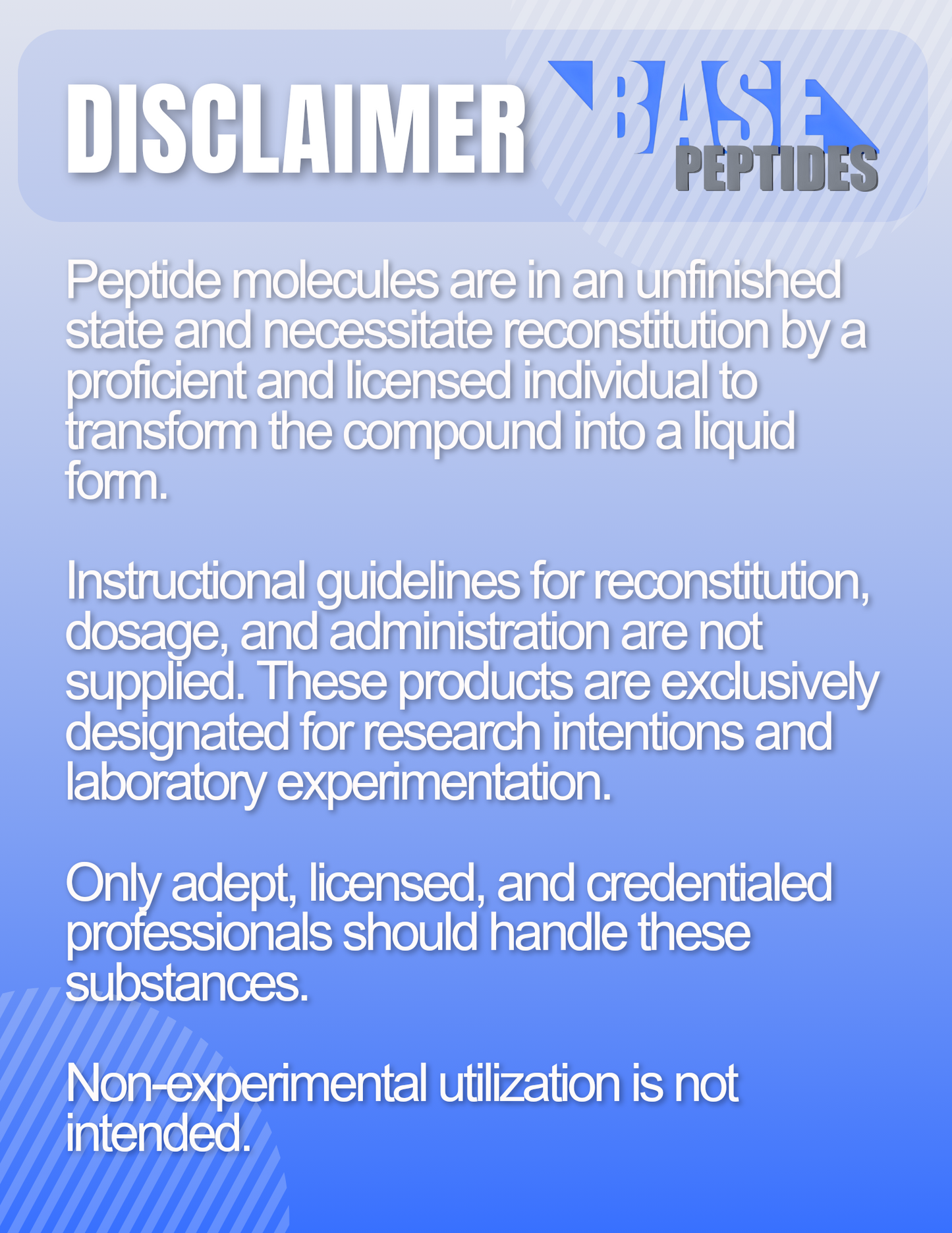Ipamorelin
Ipamorelin
Base Peptides are intended for licensed medical professionals and experienced researchers. Reconstitution required. Dosing and use instructions are not provided.
Couldn't load pickup availability
Ipamorelin — Selective GHSR (Ghrelin Receptor) Agonist
Ipamorelin is a small pentapeptide that activates the ghrelin receptor (GHSR) in the pituitary. In research, it’s used to study growth-hormone (GH) release with a reputation for high receptor selectivity and a cleaner signal on non-GH hormones.
- CAS: 170851-70-4
- PubChem CID: 9831659
- Formula / MW: C38H49N9O5 · ≈ 711.9 Da
- Sequence: Aib-His-D-2-Nal-D-Phe-Lys-NH2 (pentapeptide)
- Ipamorelin turns on the ghrelin receptor in the pituitary—one of the body’s switches for GH release.
- That signal triggers a pulse of GH without strongly pushing other pituitary hormones in most models.
- Researchers track GH and IGF-1 curves, receptor selectivity, and downstream metabolic markers.
- To map GH pulse responses from GHSR activation.
- To compare selectivity vs older secretagogues (e.g., GHRP-6).
- To explore dual-pathway designs with GHRH analogues (combinational studies).
Key Studies — What Was Tested, What Changed, Why It Matters
Human volunteer studies — dose-dependent GH response
- What was tested: Single and multiple doses of ipamorelin with serial GH/IGF-1 sampling.
- What changed: Clear, dose-dependent GH pulses were observed. Importantly, many cohorts showed minimal changes in cortisol, ACTH, or prolactin compared with some older secretagogues.
- Why it matters: This supports ipamorelin’s reputation as a more selective GHSR tool, making it useful when labs want to isolate GH-linked effects.
Comparative receptor selectivity vs legacy GHSR agonists
- What was tested: Head-to-head comparisons with agents like GHRP-6/GHRP-2 in pituitary and clinical modeling.
- What changed: Ipamorelin typically showed less spillover into non-GH pituitary hormones while maintaining a robust GH signal.
- Why it matters: Cleaner selectivity helps researchers interpret downstream biomarkers without extra endocrine noise.
GH/IGF-1 dynamics and timing
- What was tested: Time-course sampling to capture the onset, peak, and duration of GH pulses after ipamorelin.
- What changed: Predictable GH peaks within a defined window, with IGF-1 changes following expected timelines.
- Why it matters: Helps teams set sampling schedules and align ipamorelin with other interventions in combination studies.
Potential Research Applications
Endocrine Axis Mapping
- GHSR-mediated GH pulses and timing
- IGF-1 response curves and binding proteins
Comparative Secretagogue Studies
- Ipamorelin vs GHRP-6/2 selectivity
- Signal clarity in multi-hormone panels
Combination Designs
- GHSR (ipamorelin) + GHRH analogue (e.g., CJC-1295)
- Amplitude/frequency experiments on GH output
Synergistic Peptides (for Study Design)
CJC-1295 (with DAC)
- Why pair: Hits the GHRH receptor; pairing with ipamorelin (GHSR) allows dual-pathway GH stimulation.
- Angle: Map GH pulse amplitude vs frequency, and track IGF-1 exposure over longer windows.
Sermorelin / Mod GRF (1-29)
- Why pair: Short-acting GHRH-type tools for precise pulse-timing experiments.
- Angle: Compare brief vs sustained GH signaling when layered with ipamorelin.
Tesamorelin
- Why pair: Physiologic GHRH analogue often used in VAT-focused research; helpful comparator in dual-pathway designs.
- Angle: Endpoints can include IGF-1 curves, lipid panels, and imaging (where applicable).
Design Notes
- Keep arms clearly separated: GHSR-only, GHRH-only, and combination.
- Pre-define sampling times—GH peaks are time-sensitive.
- Document vehicle, pH, and storage; small handling differences affect results.
Known Concerns (Context)
- Sampling windows: GH pulses are brief—tight timing avoids missed peaks.
- Assay noise: Multi-hormone panels can introduce confounders; ipamorelin is often chosen to reduce that noise.
- General: Research use only; not a therapeutic compound.
Follow institutional SOPs and endocrine-study best practices for design and handling.
Specifications & Handling
- Form: Lyophilized powder (lot-coded)
- Purity: ≥ 99% (HPLC/MS; lot-verified)
- Storage: ≤ −20 °C; protect from light/moisture
- In solution: Aliquot promptly; avoid repeat freeze–thaw
- Additives: None unless specified per lot
- Packaging: Tamper-evident, research-only labeling
Regulatory & Use Notice
Sold for laboratory research use only. Not for human consumption, medical, or veterinary use. No human-use instructions are provided. Buyer is responsible for safe handling and regulatory compliance.
Ipamorelin Peptide Research | Selective GHSR Agonist | Growth Hormone Pulse Dynamics






